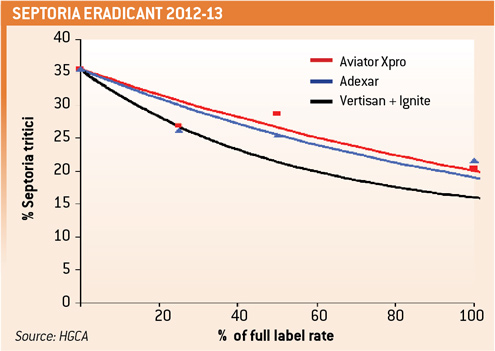Spray timing critical in battle against septoria

Cereal growers are being urged to hold back on applying their T1 winter wheat fungicide sprays this spring to avoid septoria and yellow rust taking hold of key leaves two and three.
Currently, the major concern is yellow rust, particularly in susceptible varieties, with the disease thriving and surviving through the very mild winter.
Many growers will be looking to apply a first T0 spray this month to clean up and protect crops from yellow rust, but where rust is well established there may be a need for a further spray ahead of the key T1 timing.
See also: Fungicide spend set to rise to beat wheat disease
They are advised that a T0 may be insufficient to protect rust-infected crops until the T1 timing, and urged not to fall into the trap of applying their T1 winter wheat fungicide spray too early.
ADAS fungicide expert Jonathan Blake says that the T0 spray will be very important this year to counter the rust threat, but also to keep septoria in check until the T1 spray.
“There is a chance that it could be a bad septoria year as the disease is there, but as ever much will depend on the conditions through April and May,” he explains.
Preventing a bad septoria year by maintaining the protection provided by multisite actives such as chlorothalonil or folpet at T0 is Mr Blake’s key message for growers early in their programmes.
He highlights that staying in a “protectant” situation and using fungicides to prevent the appearance of disease is better than firefighting symptoms later in the season with “curative” sprays.
The T0 spray, which is often a mix of a cheaper triazole and chlorothalonil, should be applied no more than three weeks before the crop is expected to hit growth stage 32, to ensure the crop is protected from disease until the following spray and doesn’t cause the T1 to be applied too early.
“Where disease control programmes often go wrong is when the T1 goes on too early and misses leaf three, which then extends the gap between T1 and the T2 flag leaf spray,” explains Mr Blake.
“It’s an easy trap to fall into and can result in poor disease control at T2,” he says
Active choices
A conundrum for some growers will be whether to use the more costly new-generation SDHI-containing products at the T1 timing.
Where the T0 has done its job and prevented high disease pressure until growth stage 32, an application of the most effective triazoles – prothioconazole or epoxiconazole – along with chlorothalonil, could suffice according to Mr Blake.


“If you are just requiring protectant activity, the SDHI component becomes less crucial.
“The T1 spray should be based around the triazole and multisite actives such as chlorothalonil and the SDHI on more susceptible varieties and where conditions are favouring septoria,” he says.
Mr Blake has observed yield responses of up to 1t/ha in some trials when adding SDHI fungicides to a conventional triazole plus multisite application at T1, with an average response of 0.3t/ha over the past three seasons.
“Where septoria pressure is high, the added septoria control offered by SDHIs at T1 would be expected to provide an economic benefit,” he says.
Actives
- Adexar – fluxapyroxad + epoxiconazole
- Imtrex – fluxapyroxad
- Aviator Xpro – bixafen + prothioconazole
- Siltra Xpro – bixafen + prothioconazole
- Seguris – isopyrazam + epoxiconazole
- Zulu – isopyrazam
- Vertisan – penthiopyrad
- Tracker – boscalid + epoxiconazole
Syngenta’s Seguris doesn’t have the curative activity of the other SDHI-triazole formulations such as Adexar and Aviator or DuPont’s newest straight SDHI product Vertisan, but it remains a strong option at T1.
“When applying Seguris to a clean leaf at T1, it is as good as anything else at keeping disease out until the T2 timing,” notes Mr Blake.
He adds that Vertisan partnered with epoxiconazole or prothioconazole would be a stronger curative T1 option which, along with Seguris, should be applied with chlorothalonil.
“There is a strong case to use Aviator and Adexar at T1, but I think that most will choose to use them on the flag leaf at growth stage 39,” says Mr Blake.
Growers concerned about eyespot may need to consider their choice of products a little more carefully, with two products in particular providing strong activity on the stem-based disease.
Prothioconazole-based formulations have been shown to give useful control, but BASF’s Tracker is still the leading choice for crops where eyespot control is required.
The product contains first-generation SDHI boscalid combined with epoxiconazole, and is not as strong on septoria as others, so Mr Blake says that it may need bolstering to give a more solid all-round performance.
“The addition of an increased triazole dose or another SDHI would help to boost septoria control,” he adds.
Don’t get rusty
The threat of septoria will be the main focus this year, while Mr Blake is warning that rust could continue to cause problems.
The T0 and T1 chemistry largely based around the triazoles and chlorothalonil will be active on rust and should keep the disease at bay – unless the interval between T1 and T2 becomes stretched.
With the rise of the Warrior race in recent seasons, maintaining vigilance against the disease will be vital as wheat crops move through their growth stages.
“Ideally you want to be treating rust every three weeks and with the Warrior race now predominating, delayed applications could mean trouble,” says Mr Blake.
The Warrior race is a faster cycling pathotype of yellow rust and produces more spores. Until now, cool winters have kept the disease in check since its discovery.
However, conditions have favoured yellow rust for the first time since it became dominant and experts believe that it will be much more difficult to control.
Mr Blake says that where the interval between T1 and T2 creeps over three weeks and the flag leaf still hasn’t emerged, an extra spray might be required to keep the disease at bay before the T2 timing.
“If necessary a half dose of a rust active triazole would be suitable, with the strongest choice epoxiconazole in my opinion,” says Mr Blake.
Hitting the flag
In previous seasons, the T2 flag leaf spray has been dominated by the two SDHI-triazole formulations Adexar and Aviator, which have SDHI components that are highly active on septoria.
These leading septoria control products, according to HGCA fungicide performance trials (see graphs above), have been joined by DuPont’s Vertisan – a straight formulation of penthiopyrad.
Mr Blake says that it is very difficult to pick the products apart for controlling septoria at the flag leaf timing, which is the most important leaf to protect as it contributes most to yield.
“Whichever SDHI you choose, ideally it will be applied with at least a robust rate of triazole and a multisite too.
“These products are at risk of becoming less effective because of resistance in the septoria populations so it is important to ensure there are other modes of action to reduce the pressure on the SDHIs,” explains Mr Blake.
A 1.25 litres/ha application of Adexar – the standard field rate – doesn’t deliver a three-quarter dose of its epoxiconazole component, so Mr Blake recommends the addition of chlorothalonil.
“Bayer does not recommend using chlorothalonil with Aviator as it can reduce its efficacy, but Aviator at its field rate of 1 litre/ha delivers just over a three-quarters rate of prothioconazole, so I don’t see it being a problem from a resistance management point of view,” says Mr Blake.
He warns particular care needs to be taken with the straight SDHIs such as Vertisan and Imtrex, so growers need to be sensible.
They offer great flexibility as you can set a solid baseline of triazole plus a multisite and increase the SDHI component if disease pressure increases, which you can’t do with the pre-formulations.
“At the same time you can also decrease the loading if required, which is even better from a resistance management point of view as you are reducing selection pressure,” explains Mr Blake.

